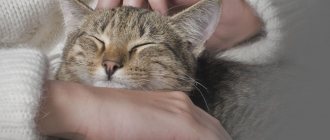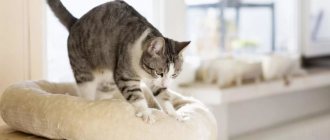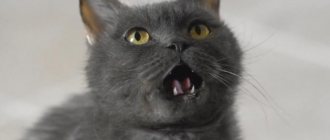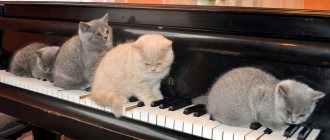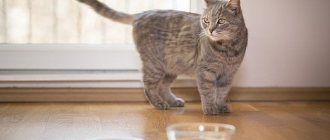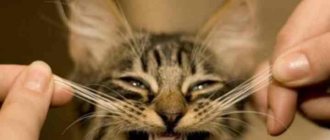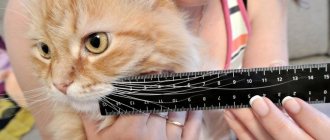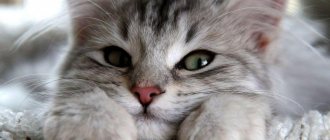Anyone who has interacted with a friendly cat or examined a cat's tongue up close knows that it is unique in many ways. The cat's tongue is truly unusual, it is long, flexible and has a very rough surface. In addition, it is also a multi-functional tool. Scientists studying a cat's tongue under a microscope have only recently discovered just how amazing it is in terms of its anatomy and abilities.
The structure of a cat's tongue
Have you ever watched a slow motion video of a cat drinking water? Its tongue acts like a tiny ball that draws water from the bowl and pushes it in a column directly into the animal's mouth. The jaws tighten around the thick water and she swallows. This all happens too quickly for the human eye to see the process in real time, but looking at the slow motion video, you'd think this technique seems to defy gravity!
There is something in common between cat and human tongues: they are both composed of transverse and longitudinal muscles. They provide mobility to this organ, which can move in different directions. A special arrangement of muscles helps these animals fold their tongue like a ladle.
Muscle tissue is covered with mucous membrane. On the outer shell there is a layer of keratin, which performs a protective function. Beneath it are capillaries that supply the organ with blood. Receptors on the surface allow you to detect bitter, sour and salty. However, cats do not distinguish sweet taste, since scientists have not found the corresponding formations in them.
The papillae on the surface of the tongue, similar in appearance to denticles, are opaque, covered with keratin, and protrude from expanded bases covering the tongue. The teeth are longer in the center and gradually become shorter on the sides and front.
Cat tongue close up
Basic groups of sounds
Three main groups of sounds made by cats have been identified: • purring - produced by a cat with its mouth closed, • calls - the mouth first opens, but then slowly closes as the sound is made, • screams - the mouth is tense and open all the time.
People need to produce sounds sequentially to achieve the necessary self-expression in that particular language. Cats can combine vowels and consonants in any form. This fact allows them to use a wider range of sounds in communication than in human speech. All cats have a common language and they speak it the same way, no matter in what conditions and where the cat lives - at home in luxury, or fighting for survival on the street. Let's look briefly at each group of sounds.
Why do cats have rough tongues?
If your pet has ever licked your hand, you will certainly feel the rough surface of his tongue. The feeling of being touched with sandpaper is caused by the papillae located on the surface of the tongue. They play an important role in helping cats stay clean and healthy. They face back towards the animal's throat, and this peculiar anatomy of the papillae allows these animals to tidy up their fur (much better than a comb). It also allows our carnivorous friends to peel meat from bones using only their tongues.
These bumps are hook-shaped and give that rough, bristly appearance that causes a “sandpaper effect” when in contact with the skin. This special structure is a kind of survival factor: by removing any dirt from the fur, the animals eliminate all traces of odors that could jeopardize hunting or could turn them into prey for other animals (there's a reason they lick their lips after they've finished eating).
Causes
A cat's tongue is a multifunctional organ that allows it to eat and drink from a spoon, as well as keep its fur clean. Normally, the color of the organ should be pink and clear. Thus, any deviations in the body appear precisely on its surface. Organ disease immediately affects the quality of nutrition. The animal ceases to receive the required amount of food and water, and, accordingly, nutrients, since pain simply does not allow eating and drinking. Among the reasons why a white coating appears on a cat’s tongue are:
- Stomatitis. A fairly common disease among cats. Manifested by whitening of the surface. The gums and tongue become swollen. Painful ulcers appear. There is inflammation of the throat and the entire mucous membrane of the oral cavity. The animal has difficulty opening its mouth, and there is significant difficulty in taking food and water. The pet is losing weight. The condition of the coat noticeably deteriorates. There is general lethargy and malaise. Exhaustion and dehydration may occur, which is extremely dangerous and requires immediate assistance;
- Glossitis. Very often, an infectious disease is diagnosed in cats. Pathogens cause severe inflammation and swelling of the organ. When the mucous membrane begins to peel off, a whitish coating is observed. The spines on the surface of the tongue disappear. The organ becomes covered with ulcers, which are very painful. The wool takes on a wet appearance. A clean-loving animal simply cannot clean its hairs due to pain. The disease requires immediate assistance from a veterinarian;
- Gingivitis also manifests itself as a whitish coating. Since inflammation occurs on the surface of the gums, first of all you can notice deviations on them, and then on the tongue;
- Tartar. The disease occurs at the initial stage with a characteristic change in the color of the tongue tissues. To remove the symptom, you can use a weak water-salt solution, which must be used to treat both the teeth and the organ itself. An analogue can be baking soda. Such treatment will prevent serious consequences;
- Gastritis. The characteristic white color can be seen on the root of the organ. The inflammatory process on the gastric mucosa occurs with darkening of the root, but such plaque can only be noticed during the period of exacerbation of the pathology;
- Fungal diseases. They are considered very dangerous illnesses. If you do not start timely treatment, your pet may be in serious danger. The most common is oral candidiasis. Among the main symptoms is a very foul odor from the mouth. The fungus very often torments cats that have been treated for a long time with antibiotics or non-steroidal drugs;
- Chemical substances. Cats are very curious, so chemicals in the house should be kept out of reach. Some substances cause burns and poisoning, and dangerous compounds upon contact with the surface of the tongue cause a change in its color.
What can be seen under a microscope
B0009732 Cat tongue, cross section
The first composite image of a section of a cat's tongue applied to a microscope slide is over a hundred years old. Yellow stripes are horizontal muscles, sparse purple stripes are vertical muscles, and black swirls are capillaries. These blue-violet spots on the jagged edge represent polarized light interacting with the keratin. A microscope image of a cat's tongue was taken by David Linstead.
Enlarged photo of a cat's tongue
This photo of a cat's tongue shows a 3mm cross section. This is a picture of 30 microphotographs taken using a digital camera and microscope. A close-up of the serrated ridge on top of the plate on the cat's tongue is the same papillae located on the surface. Under a regular microscope, a cat's tongue up close looks like a rough surface filled with thousands of tiny teeth, which is clearly visible in the photograph.
Functions of a cat's tongue
Mother Nature has equipped every cat with an anatomical Swiss Army knife. Strong and incredibly durable, used for eating and grooming, this tool is that very language. It's easy to underestimate how important he is to her health and happiness. Not only does it have a rough texture that helps with grooming and eating, but it has many other beneficial features.
Cat's sense of taste
Cats have fewer taste buds compared to humans. This affects their perception of tastes: they do not recognize sweet tastes, but they like savory tastes. While the human tongue is primarily designed for eating and pleasure, in cats this organ works differently.
Interestingly, they can taste adenosine triphosphate (ATP), which is found in living cells such as meat, but humans cannot. This is thought to naturally encourage the furry carnivores to eat meat, which is why they are carnivores. This means that they can consume other types of food such as vegetables and grains, but their diet should consist mainly of meat.
Natural wool brush
The cat washes itself
If you have a cat, then you probably know how carefully it takes care of its fur. Most of them spend a lot of time every day taking good care of themselves. Due to the special structure and presence of papillae, the tongue performs the function of a comb.
Unfortunately, this feature also has a downside. Because of their shape, these hooks tend to catch any hairs that fall out during grooming. What gets stuck on the tongue is usually swallowed. This is why many pets sometimes have to get rid of hairballs that accumulate in their stomach.
Other language properties
A cat can only drink thanks to this organ: they bend it backwards, making it look like a spoon, dipping only the tip into the water and lifting it up, sucking up the water at incredible speed before it can fall back into the bowl. This movement is very fast; in a second she manages to repeat it four times.
Seals use their tongue to regulate their body temperature. When they are hot, they cool down and restore their body temperature by licking themselves: in doing so, they moisten the fur, the saliva evaporates, thus reducing body heat.
The tongue plays an important role in the chewing process. As we mentioned earlier, thanks to this structure, meat is more easily separated from the bones of the victim, in addition, this organ helps to eat faster.
Along with the ability to detect taste, a cat's tongue is also able to sense texture and temperature. These three things - taste, temperature and texture - are the main criteria that determine a cat's food and water preferences.
Language helps strengthen bonds with offspring. Mother cats usually lick their kittens as a sign of affection. In the same way, she helps them stay clean.
The cat drinks water
Body movements
The most visible part of a cat's body is its tail. It is he who expresses the cat's feelings and emotions most clearly. Only by the tail can one judge the cat’s states and intentions. The tail is raised up - your pet is in a good mood, friendly and ready to communicate. Kittens' puffy tails are a symbol of their interest in the world around them. A raised tail is a call to play.
If the tail, on the contrary, is lowered and tousled, this means that the animal is alert. But if the fur is raised only at the base of the tail, the cat already knows what to do in this situation. Severe fear is expressed by the tail tucked between the paws.
An aggressive animal can be recognized by a highly raised, tense, tousled tail in a dominant animal and a lowered, arched tail in subordinates. A horizontally extended tail twitching rhythmically is a sign of irritation, but if the tail is knocking on the floor, the cat is more likely to be scared. If the amplitude of movements increases, and the animal literally whips itself on the sides with its tail, this is pronounced aggression.
Depending on how fast and what part of the tail the animal moves, emotions are determined. For example, a slight waving of the tip of the tail indicates relaxation; at first, a slow, and then increasingly rapid swing of the tail occurs before jumping on the object of the hunt.
The cat's pose expresses its own state, and also depends on who it is addressed to. The pose when seeing a strong opponent is different from the pose with which a cat meets an aggressive fellow tribesman. The threat pose allows the cat to look larger and more impressive: the legs are extended, the animal stands on tiptoes, the back is arched, the tail is curved, the hair stands on end. In an excited or frightened cat, the cheek nodules move, the hair on the cheeks bristles. The threatening pose is complemented by ears pressed to the back of the head, the nose is wrinkled, the fangs are exposed, and the corners of the mouth are drawn back. The cat purrs and hisses.
Cats sense the threat distance well: the distance from the enemy to the cat that no longer feels safe. Usually the animal prefers to flee, although it takes a threatening pose. But if the cat is cornered and cannot escape, and the threatening pose has no effect and the enemy continues to approach, the cat rushes to attack. This distance is called the “distance of aggression.” But for a mother cat there is no difference between “threat distance” and “aggression distance”; she will not run, but sees the enemy from afar. The cat rushes towards the enemy, jumps on all four legs, straight and outstretched, while remaining turned sideways to the enemy, the tail is raised high and fluffed. Such a cat is ready to fight to the death to protect its offspring.
In relationships with aggressive fellow cats, cats use other postures. The animal practically does not hunch its back and does not bristle its fur, but only slightly fluffs it on the withers and tail. Distance is not particularly important; the animals stand nose to nose, looking into each other's eyes, howling and purring. Cats try to remain motionless in order to suppress the enemy's morale, but the blows of the tail on the sides mean that the animal is ready to rush into a fight at any second.
When the fight begins, the first blow with the paw lands on the opponent's nose. The attacker then tries to bite the back of the opponent's head, and if this succeeds, the opponent falls on his side. A cat that does not want to engage in a fight takes a pose that combines elements of submissiveness and threat: the animal presses into the floor, lies on its side or back, putting its paws forward with its claws extended. The winner of the fight is eliminated first, trying to retain as much dignity as possible.
When communicating with people, cats rarely carry out their threats. Animals have developed inhibitions that inhibit aggression towards the owner. But if the animal is threatened by a stranger, the cat will aggressively defend itself and can seriously injure the person.
The most graceful demonstration of contentment and complacency is when a relaxed animal lies down, showing an unprotected belly. The paws are spread out to the sides, the claws are hidden, the pads can be compressed and unclenched. The eyes are half-closed, the pupils are constricted. This pose demonstrates complete trust, since the stomach is the most vulnerable place on the body.
Cats show indecision in a very interesting way. This condition is always accompanied by licking of fur. The more decisively the cat licks itself, the more serious the problem it solves at that moment. Licking calms the animal, neutralizes irritability and possible aggression. Cats often lick their cubs, other animals and even their owners, showing their affection and calling for calm.
The emotions of the owners are transferred to the animals. Nervousness, tension, the appearance of a small child who makes the cat jealous can lead to pathological behavior of the animal, expressed in the fact that the cat licks itself until certain parts of the body are completely bald.
Features of scientific data
Bioengineering scientists say a cat's tongue works like a very smart comb. Research results. The research they conducted does more than just provide insight into how one of the world's most popular pets keeps its body clean. This inspired them to create a new type of brush, TIGR (Tongue-Inspired GRooming). Studded with small, curved, flexible spikes just like a cat's tongue, the TIGR prototype easily removes loose hair or fur from people and cats, but can be cleaned with a simple swipe of a finger. This will also help make cats less allergenic, since this brush removes dead skin particles well (they contain protein that causes allergies).
Researchers have discovered that these papillae on the tongue allow cats to deliver saliva directly to the skin, which could encourage new approaches to cleaning and draining fluids on all kinds of hairy, furry and uneven surfaces. Transporting liquids is a challenge not only for animals, but also for engineers. Research shows that scientists can use the physics of basic animal behavior to answer many fundamental questions.
Researchers have found that the orientation of the papillae on the tongue is not constant. High-speed videos of domestic cats grooming themselves have revealed that the papillae rotate when the cat's tongue collides with hairballs.
This flexibility, scientists say, is key to what allows such relatively short spines to clear not only the longer, sparser outer layer of fur, but also the thick, downy undercoat next to the skin. The researchers' measurements showed that even relatively light tongue pressure during grooming allowed all types of cats to groom themselves down to the skin.
Note that the only exception is the Persian cat, a domestic breed that needs to be brushed daily to prevent possible coat problems.
